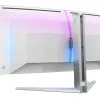Matrix speed/gaming-office-HDR experience
Despite the amazing pixel response times, you still get a large amount of blur at 60Hz due to the sample-and-hold nature of the OLED screen. Don’t expect miracles just because it’s got fast response times. There are major and obvious benefits in motion clarity as you increase to 175 Hz high refresh rate mode, though, and this is strongly encouraged for gaming wherever possible.
Gaming experience
Office Experience
The WQHD definition combined with a large 34-inch display area means no need to zoom in on windows or texts. Sharpness is average, which is partly Microsoft’s fault. The UWQHD (3440 x 1440) resolution is an expanded WQHD (2560 x 1440), so the pixel density is identical to that of 27-inch monitors with a 16:9 aspect ratio. Unfortunately, Windows 11 has not yet been adapted to the pixel layout of OLED and QD-OLED panels. Because of this, the fonts are slightly bland, and their outlines have a green-purple border, which may irritate those working with text or programming code.
On that note, the Samsung OLED panel’s triangular rather than striped subpixel structure is also slightly suboptimal for rendering fonts. Productivity is entirely natural with the 34M2C8600. The panel curve is okay because it neither enhances nor detracts from document editing. There is no image distortion in text-based apps like Word or Excel. Photos and videos look the same as they do on a flat screen. Except, of course, there’s that OLED contrast. The colors are stunning. The Evnia 34M2C8600 sensationally covers the sRGB, Adobe RGB, and DCI-P3 standards, and Delta E 2000 errors are low. White is nearly perfect (6400K), so calibration is unnecessary. However, with a colorimeter, color reproduction can still be improved. The infinite contrast is also beautiful if you look at the screen at night. Supporting 1.07 billion colors and ultra wide-color technology, this gaming monitor is also perfect for creatives who edit photos in addition to video content. The color management on the Philips Evnia 34M2C8600 monitor completely covers the sRGB spectrum, and thanks to the excellent 97.8% AdobeRGB and 99.3% DCI-P3 coverage, it should allow this gaming monitor in professional graphics. The brightness levels are more than good for use in any environment.
HDR Experience
OLED devices are ideal for HDR playback. The same goes for the Philips Evnia 34M2C8600. Combining deep black and the impressive maximum brightness of around 1000 cd/m² (APL 3%) ensures that incredibly bright images appear plastic and a real 3D effect occurs. HDR playback is excellent and fun. The luminosity in QD-OLED is higher than that of the OLED competitors and easily outperforms LCD monitors.
When watching videos on the main video streaming platforms, films, and TV series, all the strengths emerge that only (QD-)OLEDs can provide by recreating absolute blacks with much higher contrast than other panels. Even higher brightness is not necessary and can even worsen the vision of this splendid monitor, which, given the technology of its panel, is free of annoying effects such as ghosting (ghost effect which replicates a part of the image shifted in position and overlapping), bleeding (annoying effect where you see areas of light in the corners of the display when viewing low-light images) or clouding (when the backlight is not homogeneous and you see them as a sort of bright clouds).







